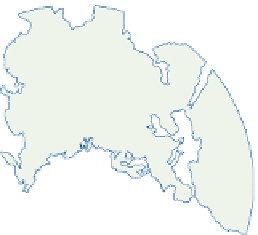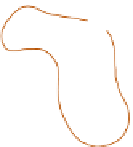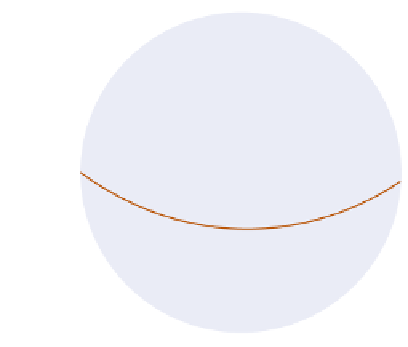Geoscience Reference
In-Depth Information
90°E
ƒ
increasing
ζ
decreases
Anticyclonic
curvature
Cyclonic
curvature
ƒ
= 0
L
180°
0°
ζ
increases
Figure 7.5
A schematic illustration of the
mechanism of longwave development in the
tropospheric westerlies.
90°W
90°E
curvature again deflects the current poleward. In
this manner, large-scale flow tends to oscillate
in a wave pattern.
While conservation of absolute vorticity helps
to explain why Rossby waves exist, an important
next consideration is the motion, or propagation,
of the wave form itself. Rossby waves, like their
shorter wavelength cousins associated with
transitory cyclones and anticyclones (see Chapter
9), can, with appropriate simplifications, be
viewed as disturbances embedded in a back-
ground zonal current. The effect of the zonal
current is to propagate the wave eastward with
respect to the surface. In other words, the
background zonal current carries the wave along
with it. However, there is a competing effect. The
latitudinal increase in the Coriolis parameter
(known as the beta plane), associated with the
concept of conservation of absolute vorticiy, acts
to propagate the wave westward with respect to
the surface. The relative importance of these two
effects determines whether, with respect to the
surface, the wave remains stationary (the two
effects cancel), migrates eastward (the background
zonal flow dominates) or migrates westward (the
beta plane effect wins). The formal relationship,
in turn built on the assumption that absolute
vorticity is conserved following the motion, is:
180°
0°
L
L
90°W
Figure 7.4
The mean contours (gpm) of the
500mb pressure surface in January and July for the
Northern Hemisphere, 1970-1999.
Source: NCEP/NCAR Reanalysis from the NOAA-CIRES
Climate Diagnostics Center.
The symbol d/d
t
denotes the time rate of
change following the motion (a total differential).
Consequently, if an air parcel moves poleward
so that
f
increases, the cyclonic relative vorticity
tends to decrease. The curvature thus becomes
anticyclonic and the current returns towards
lower latitudes. If the air moves equatorward of its
original latitude,
f
tends to decrease (
Figure 7.5
),
requiring
ζ
to increase, and the resulting cyclonic









































































